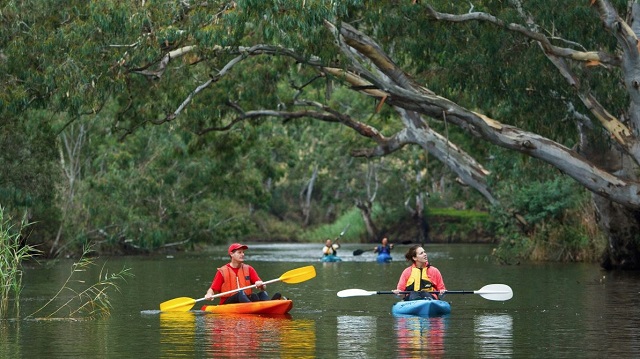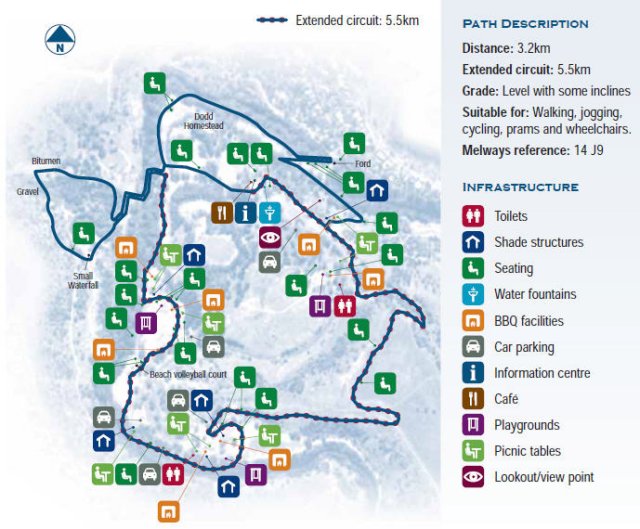Brimbank Park (Keilor East)

Brimbank Park was opened in 1976 as part of the Maribyrnong Valley Park. Fifty-five metres below the western plains, the Maribyrnong River flows at the base of a high bank. This turns the park into a big amphitheatre, ideal for scenic walks, fishing, canoeing, bird watching, kite flying, picnicking and ponding.
Things to Do
- Watch for the many water birds and enjoy the scenic walking tracks or stop in at the cafe.
- Enjoy meeting the animals at Horseshoe Bend Farm.
- Walk along the Australian Plant Trail and experience the colour and beauty of plants suitable for growing in the Keilor area.
- Cycle along the wide paths. The main trail follows the river and forms a circuit of 4.3 km. It links to the Maribyrnong River Trail, making it possible to walk or cycle from Keilor along the river as far as Footscray.
- Try canoeing on the Maribyrnong River.
- School groups - take your rubber boots and net and see what's lurking in the shallows or wetland areas.
- The Cafe, situated at the Brimbank Visitors Centre, is open during park hours.
Facilities
- Parking, toilets, picnic tables, shelters, gas barbecues, walking paths, self-guided walks, cycle paths, playgrounds, information centre and cafe are available.
- Baby change facilities.
Heritage
Brimbank Park was first settled by Europeans in the 1830s, soon after Melbourne was founded. It derived its name from the practice of the locals driving their stock 'around the brim of the bank' of the Maribyrnong River. The rich river flats on the east bank were used for market gardening until 1983. Terraces formed by the eroding river were modified for cultivation.
The Maribyrnong terraces have been closely studied for evidence of Aboriginal occupation. Keilor is one of the oldest sites of human habitation found in Australia. The Keilor cranium, dated to about 15,000 years before the present, was found in 1940 and the Green Gully skeleton in 1965. The excavations came to an end in 1982, but the site uncovered one of the most complete records of Aboriginal occupation over a period of 30,000 years.

Fauna
As you explore, you may see possums, swamp wallabies, blue tongued lizards, echidna or a huge variety of birds such as herons, cockatoos, galahs, rosellas, or even the Peregrine Falcon. Blue wrens, Yellow-tailed Thornbills and Flame Robins may be spotted as well as many species of waterbirds.
Vegetation
Native grasslands, plains and redgums line the Maribyrnong River.
Brimbank Park Nature Trail
The Walking Track will take you past many areas of interest as outlined in the Nature Trail Park notes.
Brimbank Park is rich in flora, fauna and history. As you walk, keep your eyes and ears open for an abundance of animals who call the park home including possums, ducks, fish, echidnas, turtles and peregrine falcons.
The trail distance is 3.2 km or an extended circuit is 5.5km.

Opening Hours:
Open daily, 8.30am to 5.30pm (8.30am to 7.00pm during Daylight Savings)
Review:
Brimbank Park is huge and has a large number of picnic facilities scattered about the park plus the Leaping Lizard cafe. Most of the park has been cleared of trees and it is mainly the perimeter of the park which still retains some native trees. The park has three playgrounds which are all poor. Near the entrance to the park is a scenic lookout where you can spot birds of prey and aeroplanes coming into land at Tullamarine airport.
Note: Photos from Parks Victoria
Location
Brimbank Road, Keilor East 3033 View Map
Web Links
→ www.parks.vic.gov.au/places-to-see/parks/brimbank-park
→ Brimbank Park - Nature Trail
→ Maribyrnong Valley Parklands Park Note
→ Friends of the Maribyrnong Valley
→ Walking trail (Walking Maps)
→ Brimbank Park - Visitor Guide (PDF)
→ Brimbank Park - Map (PDF)









